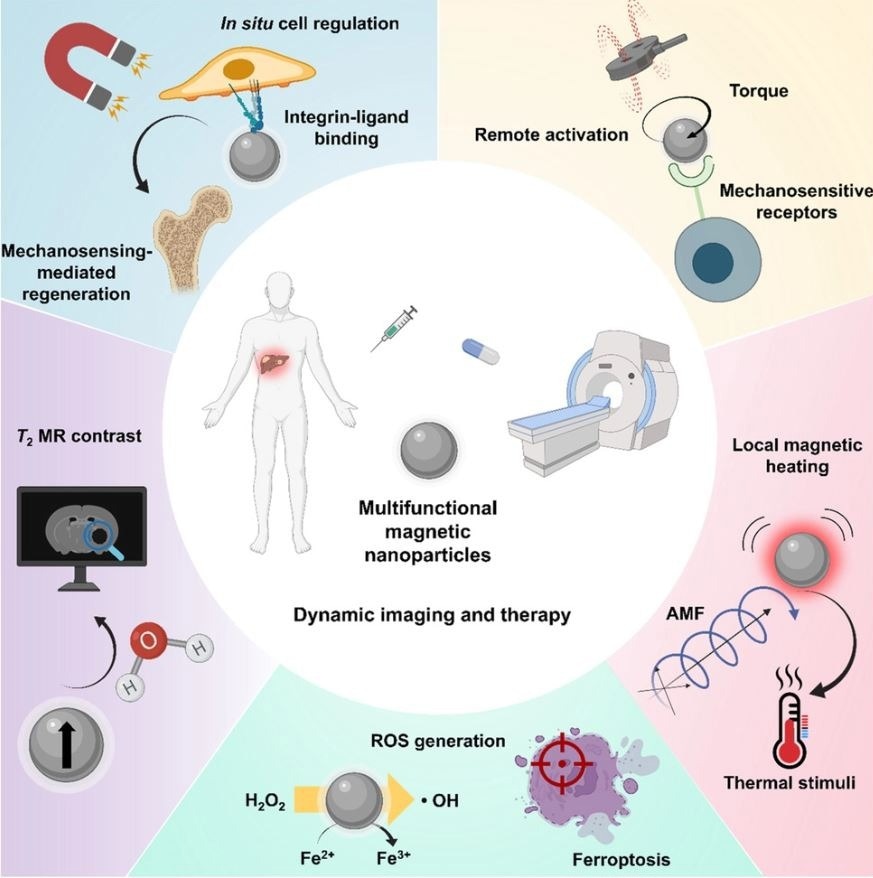Unlike non-magnetic nanomaterials, multifunctional magnetic nanoparticles have unique properties, including degradability, remote motion controllability, and diagnostic imaging. Multifunctional magnetic nanoparticles are remotely controllable via magnetic fields and have the advantages of biocompatibility and high tissue-penetrability.

Study: Multifunctional Magnetic Nanoparticles for Dynamic Imaging and Therapy. Image Credit: Ko, M.J., Hong, H., Choi, H., Kang, H., and Kim, D.H. (2022).
An article published in the journal Advanced NanoBiomed Research summarized recent advances in multifunctional magnetic nanoparticles for therapeutic applications. These applications utilize the iron ion degradation, dynamic motion, or imaging-guided targeting of multifunctional magnetic nanoparticles under diverse magnetic field modes.
The multifunctional magnetic nanoparticles controlled by the magnetic field enabled in situ spatiotemporal cell regulation, thermal energy production, and mechanosensitive molecular modification. In contrast, iron-based multifunctional magnetic nanoparticles produce reactive oxygen species (ROS) and degraded ions to facilitate ferroptosis therapy using medical imaging-guided techniques. The dynamic imaging and therapy based on multifunctional magnetic nanoparticles provide in situ feedback at each therapeutic stage.
Additionally, the difficulties in implementing magnetic dynamic imaging and therapy in clinical settings have been explored. The imaging capacity of multifunctional magnetic nanoparticles during dynamic magneto-cell regulation allows for safe, noninvasive, localized, and on-demand regulation for state-of-the-art cancer and regenerative therapy.
Multifunctional Magnetic Nanoparticles
Noninvasive dynamic therapy involves the application of light, electricity, ultrasound, and magnetic field as remote tools for cellular regulation. Controlling signaling pathways via activating cell death, manipulating individual receptors, and opening ion channels is possible through in situ application of the external energy.
Although controlled penetration and localization of external energies into cells or tissue is challenging for in vivo applications, the magnetic field is potent enough to reach deep tissues. Thus, manipulating multifunctional magnetic nanoparticles is critical in dynamically regulating cellular activity.
The behavioral, structural, and other diversified attributes of multifunctional magnetic nanoparticles, including magnetic properties, size tunability, chemical stability, large surface area, biocompatibility, and surface functionalization, improved their applicability in biomedical applications.
Consequently, multifunctional magnetic nanoparticles are utilized in various research fields owing to their high magnetic susceptibility, superparamagnetism, and inductive magnetic moment, controlled by an external magnetic field.
The response of multifunctional magnetic nanoparticles to the magnetic field allows various in situ applications, including remote cellular signal modulation, cell killing, specific in vivo targeting, on-demand therapeutic release, mechanosensing of cellular signals, and many more, regulating various intracellular pathways involved in biomedical applications.
Nanomedicines with access to individual cellular organelles promote a precise control of magneto-cellular regulation. The magnetoacting options utilizing the magnetotransduction properties of the magnetic nanoparticles can regulate various signaling pathways by using external magnetic field mediated magnetic nanoparticle motion and converting it into thermal, mechanical, and chemical energies.
Multifunctional Magnetic Nanoparticles for Dynamic Imaging and Therapy
Under a magnetic field, multifunctional magnetic nanoparticles with a broad range of physical traits can be used for dynamic imaging and therapy. In situ cell regulation is possible by leveraging biocompatibility, high tissue penetrability, and spatiotemporal and reversible controllability of the magnetic field along with magnetic nanoparticle tunability.
The iron-based composition of magnetic nanoparticles produces chemical ferroptotic signals and enables imaging-guided targeted therapy, whereas the motion controllability of magnetic nanoparticles exerts magnetic-mechanical signals or generates heat energy. These distinct benefits of multifunctional magnetic nanoparticles have made it possible to modify the cell microenvironment in situ for the regeneration of various tissues, along with immunoengineering, which still has scope for improvement.
Magnetoregulation of biological components was extensively researched, considering the advancement of nanomedicine and the multifunctional magnetic nanoparticles to convert this knowledge into useful medical applications. It will be possible to manage the proliferation, activation, or deactivation of cellular functions in stem cells and cancer cells through in situ remote activations of cellular processes, such as cell death, proliferation, cell-cell contact, or migration.
A useful noninvasive method for controlling hormone (cytokine) release, metabolic activity, and the aging process may involve magnetocellular regulation that utilizes magnetic nanoparticles. The precise control of magnetocellular regulation is made possible by well-established nanomedicines with access to specific cellular organelles.
By translating external magnetic field-mediated magnetic nanoparticle motion to mechanical, thermal, and other types of motion, subsequent magnetoacting strategies that utilize the magnetic nanoparticle’s varied magnetotransduction capabilities can alter signaling pathways.
Conclusion and Scope
In conclusion, research into the magnetic regulation of cellular behavior has a promising scope in the years to come. Future biomedicine will rely heavily on the successful development of mechanobiology, magneto-genetics, magnetic nanomedicine, and magnetocellular control.
Furthermore, each component of multifunctional magnetic nanoparticle and external magnetic field should be further researched in relation to the magnetocellular regulation for in vivo settings to transform such promising technology into practical applications.
Multidisciplinary collaboration is needed to overcome obstacles surrounding in vivo use and the development of multifunctional magnetic nanoparticles for magnetic dynamic imaging and therapy.
Reference
Ko, M.J., Hong, H., Choi, H., Kang, H., and Kim, D.H. (2022). Multifunctional Magnetic Nanoparticles for Dynamic Imaging and Therapy. Advanced NanoBiomed Research. https://onlinelibrary.wiley.com/doi/10.1002/anbr.202200053
Disclaimer: The views expressed here are those of the author expressed in their private capacity and do not necessarily represent the views of AZoM.com Limited T/A AZoNetwork the owner and operator of this website. This disclaimer forms part of the Terms and conditions of use of this website.